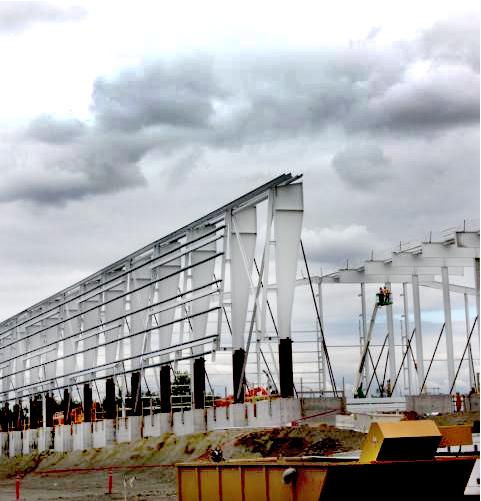SLIDESHOW UPDATE: The city dump never looked so good
Progress is happening on the new South Transfer Station at 130 S. Kenyon St. PLEASE CLICK THE PHOTO ABOVE FOR MORE PICTURES.
Wed, 11/10/2010
UPDATE for 6/22/11:
The skeleton for the new two-story, 140,000 square foot South Transfer Station in West Seattle has been built, showing clear signs of progress for the facility that will replace the old transfer station across the street (130 S. Kenyon St.).
Henry Friedman, project manager for Seattle Public Utilities said the new station is still on target for a June 2012 opening and so far there haven't been any issues overshooting the budget.
Original story from Nov. 10, 2010:
The City of Seattle will break ground on a new $50 million waste transfer station in West Seattle on Nov. 22, according to project manager Henry Friedman of Seattle Public Utilities.
The two-story, 140,500 sq. foot building with 84 parking spots is projected to be finished in June 2012. It will be built at 130 S. Kenyon St., just northwest of the existing waste transfer station and was approved on Nov. 1 by Lucas DeHerrera, Senior Land Use Planner for the Department of Planning and Development.
“We need to maintain reliable (waste) service in the city and looking through all the options we decided it was less expensive to build a new station than continue to try to remodel the old station; both in terms of cost and public benefit,” Friedman said.
According to DeHerrera’s approval report (a link can be found at the end of the story), “The proposed structure and landscape design will provide a beneficial and visually pleasing transfer station and a necessary function to the City.”
Features of the new building include an enclosed building with small entrances and exits to reduce escaping noise and odor, “a daily fine misting of the tipping floor and an odor neutralizing ventilation system to minimize odors and vehicle emissions to the extent possible,” according to the report.
The report also states that landscaping around the new facility will include 123 on-site trees, 23 street trees, 41,000 sq. feet of ground cover and 110,000 sq. feet of grass cover.
The current transfer station is an open structure and no misting is done to control odor.
“The way we handle waste is a little different than when the station was built back in 1966,” Friedman said. “Now we treat things differently based on what they are. Back in those days it didn’t matter what it was, it all went into the same pile … but now we do a lot more recycling.”
Beyond noise and odor considerations, Friedman said the new facility will be more user-friendly with more entry and exit lanes and unloading stalls.
“It will just be a better facility in terms of being able to get people through in a timely manner so they are not held up in the long lines that we have now,” he said. “That was part of what we factored in because time is money and if people are delayed and businesses are delayed that costs us too.”
As for the old transfer station, “We want to dedicate that area primarily to more recycling and recovery of materials,” Friedman said.
He said they plan to upgrade the household hazardous waste facility and provide more recycling opportunities to the public at the old site.
“It provides people with the option, before they throw stuff off, to go to the recycling area to reduce their load and hopefully that will reduce the amount it will cost,” he said. “Once they go into the transfer station they get weighed and get charged by weight.”
Seattle Public Utilities purchased the land for the new station several years ago in anticipation of the eventual need for an update, Friedman said. The $50 million price tag is for design work and construction.
“We found that we can’t really shut down the station so we had to acquire a new site and build it across the street, so that allows us to provide uninterrupted service,” he said.
Part of the approval process for new facilities is looking at environmental impacts, and DeHerrera’s report said, “LEED Gold is a goal of the project as this is a City Facility; LEED is point rating system for development that measures a proposal’s impact on the environment through various categories such as Climate Change (carbon emissions), indoor air quality, resource depletion, human health, water intake and habitat alteration among others.”
The report found the new station proposal meets LEED Gold standards. The LEED (Leadership in Energy & Environmental Design) Green Building Rating System is a, “voluntary, consensus-based standard to support and certify successful green building design, construction and operations,” according to the U.S. Green Building Council website.
The groundbreaking ceremony for the new facility is planned from 3 to 4 p.m. on Monday, Nov. 22.
To read DeHerrera’s approval report, please click here.




